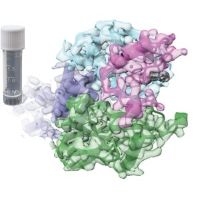Specification
| Description | Recombinant protein from the full-length sequence of Homo sapiens S-phase kinase associated protein 2 (SKP2), transcript variant 1 (NM_005983). |
| Organism | Homo sapiens (Human) |
| Expression Host | Human Cells |
| Tag Info | His or DYKDDDDK. Please contact us if you need further information or require specific designed tag. |
| Purity | Greater than 90% by SDS-PAGE gel |
| Uniprot ID | Q13309 |
| Entry Name | SKP2_HUMAN |
| Gene Names | SKP2 FBXL1 |
| Alternative Gene Names | FBXL1 |
| Alternative Protein Names | S-phase kinase-associated protein 2 (Cyclin-A/CDK2-associated protein p45) (F-box protein Skp2) (F-box/LRR-repeat protein 1) (p45skp2) |
| Application | Antigens, Western, ELISA and other in vitro binding or in vivo functional assays, and protein-protein interaction studies; For research & development use only! |
| Buffer | Purified protein formulated in a sterile solution of PBS buffer, pH7.2, without any preservatives |
| Endotoxin | Endotoxin level is < 0.1 ng/µg of protein (<1EU /µg) |
| Length | 424 |
| Molecular Weight(Da) | 47761 |
| Protein Sequence | (The sequence of expressed protein may have some variation from the sequence shown below. Please contact us for the exact sequence.) MHRKHLQEIPDLSSNVATSFTWGWDSSKTSELLSGMGVSALEKEEPDSENIPQELLSNLGHPESPPRKRLKSKGSDKDFVIVRRPKLNRENFPGVSWDSLPDELLLGIFSCLCLPELLKVSGVCKRWYRLASDESLWQTLDLTGKNLHPDVTGRLLSQGVIAFRCPRSFMDQPLAEHFSPFRVQHMDLSNSVIEVSTLHGILSQCSKLQNLSLEGLRLSDPIVNTLAKNSNLVRLNLSGCSGFSEFALQTLLSSCSRLDELNLSWCFDFTEKHVQVAVAHVSETITQLNLSGYRKNLQKSDLSTLVRRCPNLVHLDLSDSVMLKNDCFQEFFQLNYLQHLSLSRCYDIIPETLLELGEIPTLKTLQVFGIVPDGTLQLLKEALPHLQINCSHFTTIARPTIGNKKNQEIWGIKCRLTLQKPSCL |
Background
| Function | FUNCTION: Substrate recognition component of a SCF (SKP1-CUL1-F-box protein) E3 ubiquitin-protein ligase complex which mediates the ubiquitination and subsequent proteasomal degradation of target proteins involved in cell cycle progression, signal transduction and transcription (PubMed:11931757, PubMed:12435635, PubMed:12769844, PubMed:12840033, PubMed:15342634, PubMed:15668399, PubMed:15949444, PubMed:16103164, PubMed:16262255, PubMed:16581786, PubMed:16951159, PubMed:17908926, PubMed:17962192, PubMed:22770219, PubMed:32267835). Specifically recognizes phosphorylated CDKN1B/p27kip and is involved in regulation of G1/S transition (By similarity). Degradation of CDKN1B/p27kip also requires CKS1. Recognizes target proteins ORC1, CDT1, RBL2, KMT2A/MLL1, CDK9, RAG2, FOXO1, UBP43, YTHDF2, and probably MYC, TOB1 and TAL1 (PubMed:11931757, PubMed:12435635, PubMed:12769844, PubMed:12840033, PubMed:15342634, PubMed:15668399, PubMed:15949444, PubMed:16103164, PubMed:17962192, PubMed:16581786, PubMed:16951159, PubMed:17908926, PubMed:32267835). Degradation of TAL1 also requires STUB1 (PubMed:17962192). Recognizes CDKN1A in association with CCNE1 or CCNE2 and CDK2 (PubMed:16262255). Promotes ubiquitination and destruction of CDH1 in a CK1-dependent manner, thereby regulating cell migration (PubMed:22770219). {ECO:0000250|UniProtKB:Q9Z0Z3, ECO:0000269|PubMed:11931757, ECO:0000269|PubMed:12435635, ECO:0000269|PubMed:12769844, ECO:0000269|PubMed:12840033, ECO:0000269|PubMed:15342634, ECO:0000269|PubMed:15668399, ECO:0000269|PubMed:15949444, ECO:0000269|PubMed:16103164, ECO:0000269|PubMed:16262255, ECO:0000269|PubMed:16581786, ECO:0000269|PubMed:16951159, ECO:0000269|PubMed:17908926, ECO:0000269|PubMed:17962192, ECO:0000269|PubMed:22770219, ECO:0000269|PubMed:32267835}.; FUNCTION: Through the ubiquitin-mediated proteasomal degradation of hepatitis C virus non-structural protein 5A, has an antiviral activity towards that virus. {ECO:0000269|PubMed:27194766}. |
| Pathway | Protein modification; protein ubiquitination. |
| Protein Families | |
| Tissue Specificity |
QC Data
| Note | Please contact us for QC Data |
| Product Image (Reference Only) |  |

